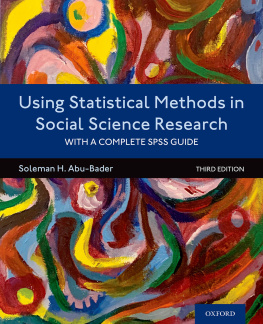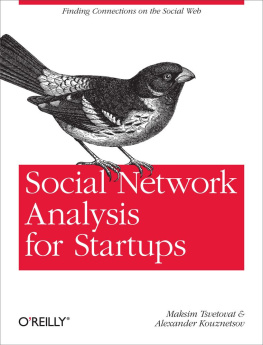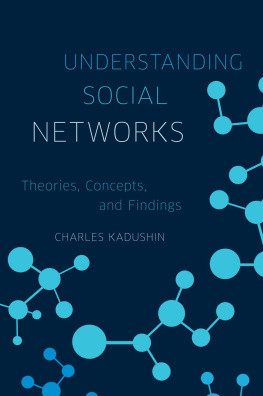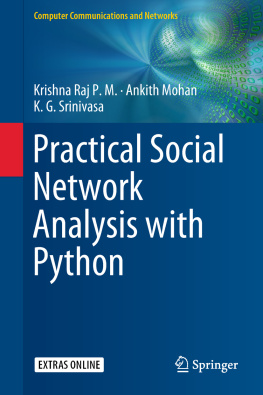Analyzing Social Networks
Analyzing Social Networks
2nd Edition
Stephen P Borgatti
Martin G Everett
Jeffrey C Johnson
SAGE Publications Ltd
1 Olivers Yard
55 City Road
London EC1Y 1SP
SAGE Publications Inc.
2455 Teller Road
Thousand Oaks, California 91320
SAGE Publications India Pvt Ltd
B 1/I 1 Mohan Cooperative Industrial Area
Mathura Road
New Delhi 110 044
SAGE Publications Asia-Pacific Pte Ltd
3 Church Street
#10-04 Samsung Hub
Singapore 049483
Stephen P. Borgatti, Martin G. Everett and Jeffrey C. Johnson
First edition published April 2013. Reprinted 2013, 2015, 2016 (twice), and 2017.
This second edition first published 2018.
Apart from any fair dealing for the purposes of research or private study, or criticism or review, as permitted under the Copyright, Designs and Patents Act, 1988, this publication may be reproduced, stored or transmitted in any form, or by any means, only with the prior permission in writing of the publishers, or in the case of reprographic reproduction, in accordance with the terms of licences issued by the Copyright Licensing Agency. Enquiries concerning reproduction outside those terms should be sent to the publishers.
Library of Congress Control Number: 2017941096
British Library Cataloguing in Publication data
A catalogue record for this book is available from the British Library
ISBN 978-1-5264-0409-1
ISBN 978-1-5264-0410-7 (pbk)
Editor: Jai Seaman
Assistant editor: Aly Owen
Production editor: Tom Bedford
Copyeditor: Christine Bitten
Proofreader: Audrey Scriven
Indexer: David Rudeforth
Marketing manager: Susheel Gokarakonda
Cover design: Shaun Mercier
Typeset by: C&M Digitals (P) Ltd, Chennai, India
Printed in the UK
This book is for Lin Freeman, our mentor. Much of what is said in this book comes originally from Lin, either through classes or informal conversations.
Contents
Acknowledgements
We would like to acknowledge the considerable help of Bill Stevenson (Boston College), who wrote the original draft of the data collection chapter, as well as the guidance provided by the questions posed to us over the years from many workshop participants. We would also like to thank Michael Zurek for his help on the glossary.
Preface
Welcome to the world of social network analysis. This book is intended as a general introduction to doing network research. The focus is on methodology, from research design and data collection to data analysis. Of course, since methodology and theory are deeply intertwined, this book is also about network theory. What the book is not is a survey of empirical research on social networks.
The book is also meant to be relatively non-technical. We try not to simplify to the point of being inaccurate, but, when forced to make a choice, we have opted for intelligibility and transmitting the spirit of an idea. In each case, however, we provide pointers to the appropriate technical literature so that the reader can get a fuller picture if desired.
Doing network analysis implies using network analysis software. A number of packages exist, including UCINET (Borgatti et al., 2002) and Pajek (Batagelj and Mrvar, 1998). As two of the authors of UCINET are authors of this book, we use UCINET for most of our examples. However, we do not intend this book to be a tutorial on UCINET. This means we focus on generic data analysis issues and, in general, do not give detailed UCINET-specific instructions. For those interested, however, the books website (, which is much more UCINET-focused than the rest of the book.
One of the issues we faced in writing this book was how to keep it down to a reasonable size and maintain an understandable flow. We wanted to write a guide rather than an encyclopedia. As a result, we had to leave some things out. In general, our approach to this was to include only methods and concepts that are in demand and tend to be useful in a variety of settings. For example, although the k -plex (Seidman and Foster, 1978) is one of our favorite network concepts, we left it out of the chapter on subgroups because, in general, other approaches tend to be more practical. Similarly, in the chapter on centrality, we successfully resisted the temptation to present even a small fraction of all the measures that are available in the literature.
Throughout the book, we use empirical examples to illustrate the material. Because social networks are studied in a variety of traditional academic disciplines, we draw our examples from a wide variety of fields, including anthropology, sociology, management and health care.
The book consists of 15 chapters that, in our minds at least, are logically grouped into four sections. The first section consists of an introduction ( reviews in very simple terms some of the basic concepts in graph theory and matrix algebra. A reader familiar with network analysis could skip these two chapters, but we think it advisable to familiarize yourself with our notation and terminology.
The next section has six chapters which are all about research methods. is about statistical techniques for testing hypotheses with network data. These are techniques specifically tailored for the special challenges of network data, such as non-independence of observations. The first part of the chapter is about using permutation-based versions of standard techniques such as correlation and regression. The second part is about exponential random graph and SIENA models. These techniques are not available in UCINET, and the statistical underpinnings of the models are far outside the scope of this book. However, we have included a brief introduction so that the reader is at least familiar in the broadest terms with these options and can then decide whether to explore them further.
The third section of the book is about the core concepts and measures of network analysis. discusses ways of conceptualizing and measuring structural similarities in how nodes are connected in the network.
The final section of the book consists of three cross-cutting chapters organized around different kinds of data. is concerned with designing, collecting and analyzing ego network data. We note that there is no chapter devoted to longitudinal data, but examples of longitudinal analyses can be found in many of the chapters in the network concepts section.
With certain exceptions, the chapters do not depend heavily on each other, so the book does not need to be read sequentially. One reviewer has suggested beginning with on analyzing network data.
The second edition contains some new sections and additional material as well as some changes to the text in order to clarify and improve the flow. In addition, we have added some problems and exercises to each chapter.
We are grateful to our mentor, Lin Freeman, for teaching us social network analysis in the first place. It is his take on the field that this book presents. We also thank Roberta Chase for many painful hours editing our less-than-perfect prose, Adam Jonas for managing all the (constantly changing) figures and tables, Chris Cooper for managing the references, and Filip Agneessens and Eric Quintane for their close reading of . We also thank Bill Stevenson for writing the original draft of the data collection chapter. Finally, we acknowledge NSF, DTRA, ARO and DARPA, whose grants have supported portions of this work.













